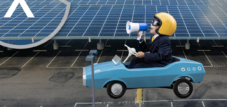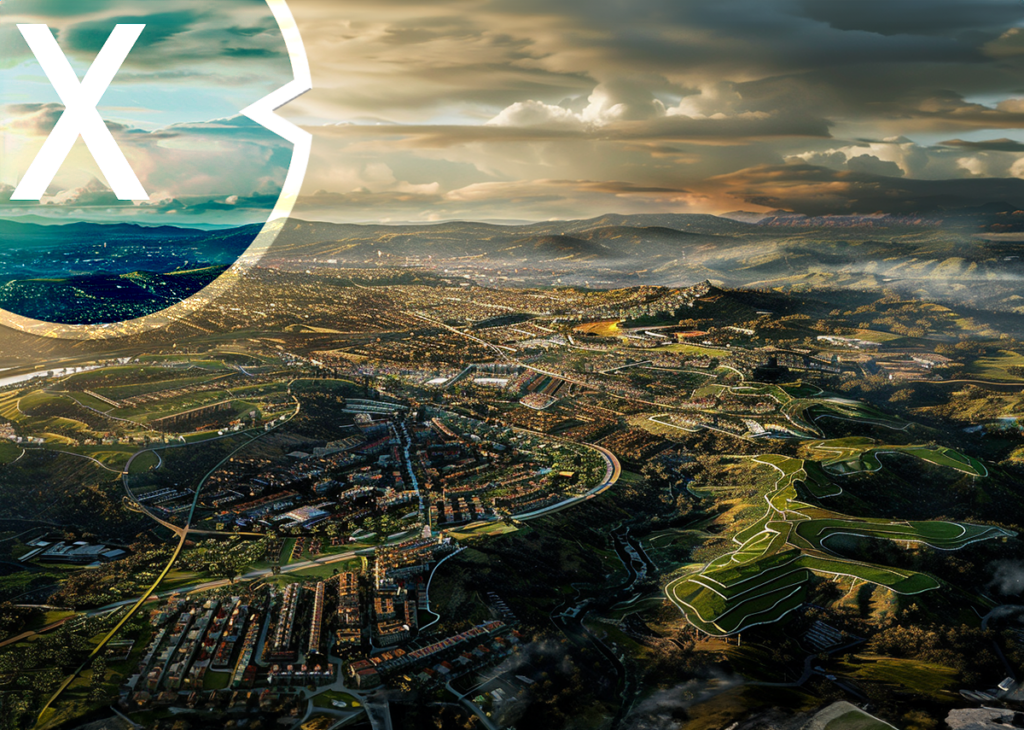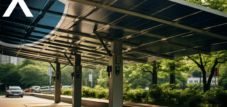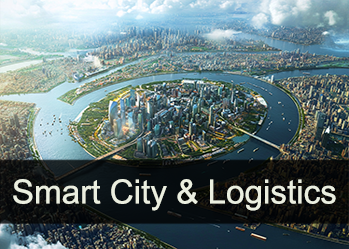Hurdles and challenges of urbanization: Key areas for sustainable urban development
Language selection 📢
Published on: September 16, 2024 / update from: September 16, 2024 - Author: Konrad Wolfenstein

Hurdles and challenges of urbanization: Key areas for sustainable urban development - Image: Xpert.Digital
🌍🌆 Global migration to cities - opportunities and risks - from the countryside to the city: the dynamics of urbanization
🌱🔑 Urbanization is a global phenomenon that has steadily increased in importance since industrialization. People move to cities, often with the hope of a better life, better job opportunities and access to modern infrastructure. But this movement does not only bring advantages. Many cities are not adequately prepared for the influx of new residents, which could lead to increasingly serious problems in the coming decades.
More about this here in one of the leading blogs on the topic:
🌆 Why people move to cities
Cities have always had a special attraction for people. They offer numerous advantages that living in rural areas often cannot offer. These include:
1. Jobs
Urban areas have a larger and more diverse range of jobs, particularly in modern industries, services and technology companies. “For many people, cities represent a world of new opportunities, including jobs.” This sentence aptly describes why so many people see urbanization as an opportunity for themselves.
2. Education
Cities tend to offer better educational facilities, ranging from schools to universities and other training opportunities. These enable residents to improve their skills and therefore their job prospects.
3. Healthcare
In urban areas, access to medical care is much easier and more advanced. More hospitals, specialized clinics and doctors trained in various disciplines make cities attractive to people seeking access to better healthcare.
4. Infrastructure and services
Cities have a developed infrastructure. A well-developed transport network, modern communication options and quick access to water and energy are just some of the advantages that make life in the city more attractive.
🚧 The dark side of urbanization
All of these advantages mean that more and more people are moving to cities. But this influx also has serious consequences. Without forward-looking and sustainable urban planning, many cities risk collapsing under the strain of growth.
By 2024, around 50 percent of the world's population will already live in urban areas. According to calculations, this proportion will rise to over 60 percent by 2050. The greatest growth is expected in the regions of Africa and Asia, where cities are sometimes growing at a breathtaking pace.
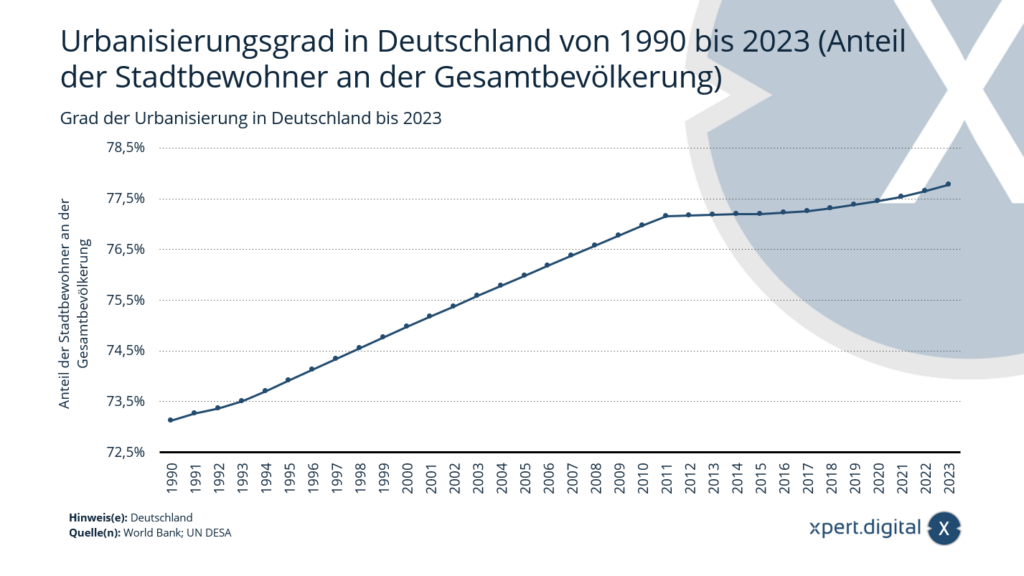
Degree of urbanization: Proportion of city residents to the total population in Germany 1990-2023 - More and more people in Germany live in cities. In 2023, around 77.77 percent of Germany's total population lived in cities - Image: Xpert.Digital
Suitable for:
“There is a strong connection between urbanization and economic growth. Globally, cities are responsible for over 80 percent of the gross national product.” This connection shows that cities are crucial drivers of the global economy, but they must grow in a sustainable manner in order not to face serious problems in the coming decades.
🌱 The challenges of urban planning
Rapid urbanization brings with it many challenges that need to be addressed. Cities that are not prepared for the influx of new residents often suffer from the following problems:
1. Overloaded infrastructure
Many cities do not have the capacity to cope with the rapid increase in population. This particularly affects the transport and energy infrastructure. Overcrowded streets, a lack of public transport and an insufficient energy supply are often the consequences. If these problems are not addressed quickly, they can significantly reduce the quality of life in the city.
2. Lack of housing
Another major problem caused by urbanization is the lack of affordable housing. In many cities, especially in the metropolises of the Global South, huge slums and informal settlements are emerging in which people live under precarious conditions. These settlements are often overcrowded and lack basic infrastructure such as water, sanitation or electricity. Living in such environments poses major health risks.
3. Environmental pollution and climate change
A particularly pressing problem of urbanization is environmental pollution. Cities, especially in emerging countries, are major contributors to greenhouse gases. Industrial activities, traffic and heating cause enormous air pollution, which can have serious health consequences for residents. Cities also generate enormous amounts of waste that is often not disposed of adequately.
The so-called “urban heat islands” are another problem that is exacerbated by urbanization. Due to the dense development and lack of green spaces, cities are often significantly warmer than the surrounding rural areas. This heat can significantly impact quality of life and cause health problems, particularly for the elderly and children.
🔑 Sustainable urban planning as a solution
In order to minimize the negative consequences of urbanization, sustainable urban planning is of utmost importance. There are already many approaches and solutions that can help overcome the challenges of urbanization.
1. Sustainable energy supply
The use of renewable energies, such as photovoltaics, can help make cities less dependent on fossil fuels. Solar energy is a promising solution, especially in sunny regions, to meet the energy needs of cities in a sustainable manner. Wind energy and biomass could also play an important role.
2. Green spaces and parks
Green spaces in cities are not only important for aesthetics, but also for the well-being of residents. They offer a retreat from the hustle and bustle of the city and improve air quality. They also contribute to cooling urban heat islands and help mitigate the consequences of climate change.
Suitable for:
3. Intelligent traffic planning
Forward-looking traffic planning can help reduce traffic stress in cities. The expansion of public transport, cycle paths and pedestrian zones can help reduce private traffic. This not only leads to less traffic congestion, but also a reduction in CO2 emissions.
4. Sustainable water management
Water is one of the most valuable resources, especially in growing cities. Sustainable water management that relies on the recovery and reuse of water can help reduce water consumption. In many cities, especially in dry regions, this is one of the most pressing challenges.
5. Equal access to resources
Another goal of sustainable urban planning should be to provide all residents of a city with equal access to resources. In addition to education and healthcare, this also includes things like public services, work and digital media. Without this access, social inequalities can be further increased, which can lead to tensions and conflicts within the urban community.
⚡ Development brings both opportunities and risks
Urbanization is a phenomenon that cannot be stopped. In the next few decades, more and more people will move to cities, especially in the regions of Africa and Asia. But this development brings with it both opportunities and risks. In order to maximize the positive effects of urbanization and minimize the negative consequences, forward-looking and sustainable urban planning is essential. This is the only way cities can continue to be places where people want to live and work in the future.
📣 Similar topics
- 🌆 Advantages of urbanization
- 🌍 Challenges of urbanization
- 🌳 Importance of green spaces in cities
- 🏘️ Lack of affordable housing
- 🚆 Intelligent traffic planning
- 🧑⚕️ Access to healthcare
- 🔋 Sustainable energy supply in cities
- 🌡️ Climate change and urban heat islands
- 📚 Better educational opportunities in urban areas
- 💧 Importance of water management
#️⃣ Hashtags: #Urbanization #Urban Planning #Sustainability #Infrastructure #Environment
📌 Other suitable topics
🌆🚀 The challenges of urbanization: A comprehensive look
🌇 In the modern world, cities exert an irresistible attraction on people. The promise of a better life attracts many from rural areas to urban centers. However, this trend towards urbanization brings not only opportunities but also significant challenges. By 2024, around 50 percent of the world's population already lives in urban areas, and this proportion is predicted to rise to over 60 percent by 2050. The largest population movements are expected in Africa and Asia.
🔥 The attraction of cities
Cities offer a variety of advantages that have always attracted people:
- Diverse jobs
- Extensive infrastructure
- Wide range of educational opportunities
- Quality healthcare
- Varied leisure and cultural offerings
These factors give the impression of unlimited opportunities and prosperity. In fact, there is a strong connection between urbanization and economic growth. Cities worldwide are responsible for over 80 percent of the gross national product. They act as engines of economic development and offer numerous opportunities for personal and professional growth.
📜 Historical development of urbanization
Urbanization is not a new phenomenon. Since industrialization in the 18th and 19th centuries, urbanization has accelerated rapidly. The settlement of factories and companies in metropolitan areas created an enormous need for workers. At the same time, job prospects drew people from rural areas to cities.
This development has continued and intensified over time. With globalization and technological advancements, cities have become centers of innovation and economic growth. They not only offer jobs, but also opportunities for education, research and cultural exchange.
⚠️ Challenges of modern urbanization
Despite the many benefits, rapid urbanization poses significant challenges. Many cities are unprepared for massive population growth, which leads to a number of problems:
🏠 Housing shortage and social inequality
One of the most pressing challenges is the provision of sufficient and affordable housing. In many major cities around the world, the influx of people is leading to overcrowded neighborhoods and rising rents. This can increase social inequalities and lead to the formation of slums or informal settlements.
To address this problem, cities must develop innovative housing concepts. This includes:
- Densification of existing residential areas
- Conversion of industrial wasteland
- Promoting social housing
- Developing sustainable and affordable construction methods
🏗️ Infrastructural challenges
The growing population places enormous demands on the urban infrastructure. Transport systems, energy supply, water supply and waste disposal must be expanded and modernized.
Transport and mobility
Coping with increasing traffic volumes is a central task. Cities must develop efficient and sustainable mobility concepts that reduce private transport and strengthen local public transport. This includes:
- Expansion of cycle paths and pedestrian zones
- Promoting car sharing and e-mobility
- Investments in modern local transport systems such as subways and trams
- Implementation of intelligent traffic control systems
power supply
Sustainable energy supply is another critical point. Cities must advance the transition to renewable energy to meet increasing energy needs in an environmentally friendly way. Photovoltaic systems on roofs, wind turbines in suburban areas and innovative energy storage solutions are important building blocks of a sustainable urban energy supply.
Water and waste management
The supply of clean water and the disposal of waste pose major logistical challenges to growing cities. Innovative solutions such as:
- Water-saving technologies
- Rainwater harvesting
- Efficient wastewater treatment
- Modern recycling plants
- Promoting the circular economy
are necessary to overcome these problems.
🌳 Environmental and health aspects
The densification of urban spaces has significant impacts on the environment and the health of city residents.
Air pollution and climate change
Cities are responsible for a large proportion of global CO2 emissions. Improving air quality and reducing the ecological footprint are therefore central tasks of urban development. Measures include:
- Promoting low-emission means of transport
- Energy efficient buildings
- Expansion of green spaces as natural CO2 sinks
- Implementation of smart city technologies to optimize resource consumption
Urban heat islands
The phenomenon of urban heat islands, in which cities are significantly warmer than the surrounding area, is increasing due to densification and climate change. This can lead to health problems, especially in the elderly and children. Countermeasures include:
- Creation of green spaces and parks
- Greening of roofs and facades
- Use of bright, reflective surfaces
- Improving ventilation through intelligent urban planning
Mental health and quality of life
The densification and often hectic lifestyles in cities can have a negative impact on mental health. Creating recreational spaces, promoting community activities and providing green spaces are important aspects of improving the quality of life in cities.
🏛️ Social challenges
Urbanization also brings significant social challenges.
Integration and social cohesion
Immigration from different regions and cultures requires concepts for integration and promotion of social cohesion. Cities must create spaces for intercultural exchange and actively combat discrimination.
Education and equal opportunities
Equal access to education is crucial for social mobility and the future viability of cities. Investments in schools, universities and further education institutions as well as the promotion of digital educational offerings are important steps.
Labor market and economic participation
The creation of jobs and the promotion of entrepreneurship are central tasks in order to enable the economic participation of all population groups. This also includes supporting start-ups and promoting the local economy.
🚀 Approaches to solutions and future perspectives
To overcome the challenges of urbanization, holistic and innovative approaches are required.
🌐 Smart cities and digital transformation
Digitalization offers enormous potential for urban development. Smart city concepts enable more efficient use of resources, improve mobility and increase the quality of life. Examples are:
- Intelligent traffic control
- Digital citizen services
- Real-time monitoring of environmental data
- Networked energy systems
♻️ Sustainable urban planning
A foresight and sustainable urban planning is the key to coping with the urbanization challenges. Concepts such as the “15-minute city”, in which all important facilities of daily life can be reached within 15 minutes on foot or by bike.
📣 Citizen participation and participatory urban development
The involvement of citizens in planning and decision-making processes is crucial for the acceptance and success of urban development measures. Digital platforms and innovative participation formats can promote dialogue between administration and citizens.
🤝 International collaboration and knowledge exchange
Given the global dimension of urbanization, the exchange of knowledge and best practices between cities worldwide is of great importance. International networks and partnerships can help to spread successful solutions and learn from each other.
✨ Potentials of urbanization
Urbanization is a complex and multifaceted process that brings with it both opportunities and challenges. Innovative, sustainable and integrative approaches are required to harness the potential of urbanization and at the same time overcome the associated problems. Cities must develop into livable, resilient and inclusive spaces that combine economic dynamism with environmental sustainability and social justice.
The future of urbanization will largely depend on how well we succeed in bringing the various aspects of urban development – from infrastructure to the environment to social issues – into harmony. Only through a holistic approach and the active involvement of all stakeholders can the challenges of urbanization be mastered and the opportunities of this global trend be optimally exploited.
📣 Similar topics
- 🏙️ Challenges of modern urban development
- 🌍 The global dimension of urbanization
- 🏠 Combat housing shortages in large cities
- 🚦 Innovative solutions for traffic and mobility
- 💧 Sustainable water and energy management in cities
- 🌿 Environmentally friendly urban planning for the future
- 🌡️ Strategies against urban heat islands
- 🤝 Integration and social cohesion in urban spaces
- 🧠 Impact of urbanization on mental health
- 📊 Digitalization as the key to the smart city
#️⃣ Hashtags: #Urbanization #Urban Development #Sustainability #Traffic Planning #SocialJustice
We are there for you - advice - planning - implementation - project management
☑️ Smart City & Factory: Industry expert for energetic 5G buildings and halls as well as advice and installation of solar systems
☑️ Xpert.Plus - logistics consulting and logistics optimization
☑️ Industry expert, here with his own Xpert.Digital Industry Hub with over 2,500 specialist articles
I would be happy to serve as your personal advisor.
You can contact me by filling out the contact form below or simply call me on +49 89 89 674 804 (Munich) .
I'm looking forward to our joint project.
Xpert.Digital - Konrad Wolfenstein
Xpert.Digital is a hub for industry with a focus on digitalization, mechanical engineering, logistics/intralogistics and photovoltaics.
With our 360° business development solution, we support well-known companies from new business to after sales.
Market intelligence, smarketing, marketing automation, content development, PR, mail campaigns, personalized social media and lead nurturing are part of our digital tools.
You can find out more at: www.xpert.digital - www.xpert.solar - www.xpert.plus








